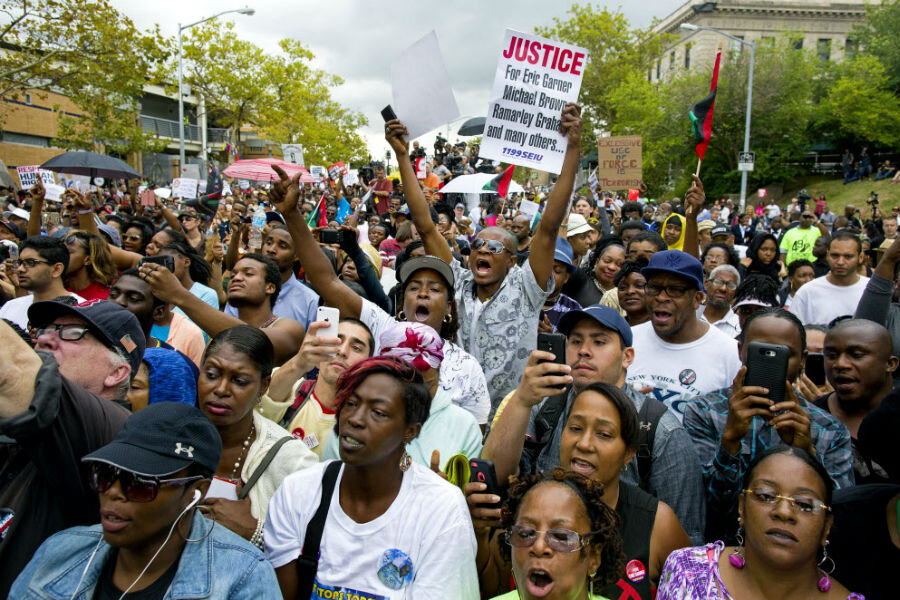Eric Garner grand jury probe shows similarities to Michael Brown case
Loading...
| New York
Just a week after a Missouri grand jury declined to bring charges against former Ferguson Police Officer Darren Wilson, New York City is bracing for another long-awaited and controversial grand jury decision.
A Staten Island grand jury, which has been hearing evidence since Sept. 29, has heard from its final witnesses and could hand down a decision about whether to indict New York Police Officer Daniel Pantaleo in the chokehold death of Eric Garner as early as Wednesday, according to reports.
Like its Missouri counterpart, the Staten Island grand jury has been unusual, both in the duration of the proceedings and the amount of evidence presented. Meeting for months, the secret panel of 16 or as many as 23 jurors has been hearing a full array of evidence, including the testimony of the potential defendant, New York Police Officer Daniel Pantaleo.
District Attorney Daniel Donovan has said little during the past two months about the secret grand jury proceedings, which must decide whether to bring charges against Officer Pantaleo, a white officer eight years on the force, who wrestled Mr. Garner to the ground with a headlock maneuver on the afternoon of July 17, even as the 6-foot, 3-inch, 350-pound father of six cried out, “I can’t breathe” numerous times.
The incident, dramatically captured on video by multiple bystanders with smartphones on the Staten Island sidewalk, provided the early backdrop to the often violent protests to the shooting of Mr. Brown in Ferguson, Mo., just a few weeks later. Both became symbols of the deep, decades-long divisions between police departments and black communities in a year marked by angry protests and civil unrest.
And just as St. Louis Prosecutor Robert McCulloch did with Officer Wilson, District Attorney Donovan brought in Officer Pantaleo to testify in his own defense, without being subject to adversarial cross examination.
In most cases, legal experts say, a prosecutor presents a grand jury only with select evidence to simply establish “probable cause” for an indictment, and the potential defendant is by definition the prosecutor’s legal adversary.
“But it’s very challenging for a local prosecutor, who oftentimes wins elections with the support of local police officers, and works very closely with local police officers each and every day, to bring a case against a cop,” says Jason Leventhal, a former Staten Island assistant district attorney who now represents clients bringing civil rights cases against the NYPD.
“The internal pressures that a local prosecutor receives from their brothers in law enforcement – these are their partners working together everyday, so it creates a very challenging environment for a prosecutor to seek and indictment, let alone a conviction, of a police officer.”
Pantaleo, an officer who lives in Staten Island, told his side of the incident to the grand jury for two hours on Nov. 21.
“He was gratified to tell his story, he was relieved," said Stuart London, Pantaleo’s attorney, to CNN on Saturday. "He was anxious and anxiety-filled prior to that," Mr. London said. "He is cautiously optimistic, and knows that his fate is in their hands now."
In Missouri, Mr. McCulloch was criticized for taking the unusual step of presenting the entirety of his evidence to the grand jury, including the four-hour testimony of Wilson. None of the evidence was subjected to cross examination or hostile scrutiny, however, critics say.
And it is not difficult for a prosecutor to get an indictment. In 2010, federal prosecutors sought indictments in about 162,000 cases, according to the Bureau of Justice Statistics. Grand jurors declined to return an indictment in 11 of these.
“[When] the prosecutor handled the Wilson case in a radically different manner, this signaled to the grand jurors that they were not expected to indict. And they did not,” wrote Marjorie Cohn, a criminal defense attorney and professor at Thomas Jefferson School of Law in San Diego, in an essay in The Huffington Post last week.
Many observers in New York see a similar strategy at play in the Garner grand jury.
“The length of the grand jury proceedings has given me pause, and there’s always the possibility that the district attorney is using the grand jury process to insulate him from the public scorn and criticism that would follow if he chose not to bring a case that the public believes should be brought,” says Mr. Leventhal of the law firm Leventhal & Klein.
“Presenting evidence this way insulates the DA from the decision,” he continues. “Even if he was seeking an indictment – an indictment that would be unpopular, and he might be concerned with the fallout from fellow law enforcement partners – it also serves that purpose to be able to say, ‘It wasn’t my decision, I put all the evidence in, and it was the grand jury’s decision.’ ”
On Monday, NYPD Commissioner Bill Bratton met with local clergy, community leaders, and elected officials in Staten Island to discuss the possible fallout of the impending grand jury decision, including the possibility of Ferguson-like violence.
"Here on Staten Island, Eric Garner had a lot of friends, especially in that area, and he's very, very well missed by a lot of people who's anxiously waiting the decision," said Cynthia Davis, a leader with the Rev. Al Sharpton’s National Action Network, to NY1. "So I even think maybe some agitators may try to worm their way in and try to cause problems, but we're just praying and hoping that that doesn't happen."








